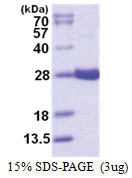GSTA4 (1-222, His-tag) Human Protein
CAT#: AR50328PU-N
GSTA4 (1-222, His-tag) human recombinant protein, 0.5 mg
Size: 100 ug
|
Need it in bulk or customized? Get a free quote |
CNY 14,920.00
货期*
详询
规格
Specifications
| Product Data | |
| Species | Human |
| Expression Host | E. coli |
| Expression cDNA Clone or AA Sequence |
MGSSHHHHHH SSGLVPRGSH MGSHMAARPK LHYPNGRGRM ESVRWVLAAA GVEFDEEFLE TKEQLYKLQD GNHLLFQQVP MVEIDGMKLV QTRSILHYIA DKHNLFGKNL KERTLIDMYV EGTLDLLELL IMHPFLKPDD QQKEVVNMAQ KAIIRYFPVF EKILRGHGQS FLVGNQLSLA DVILLQTILA LEEKIPNILS AFPFLQEYTV KLSNIPTIKR FLEPGSKKKP PPDEIYVRTV YNIFRP
|
| Tag | His-tag |
| Predicted MW | 28.3 kDa |
| Concentration | lot specific |
| Purity | >95% by SDS - PAGE |
| Buffer | Presentation State: Purified State: Liquid purified protein Buffer System: 20 mM Tris-HCl buffer, pH 8.0, 20% glycerol, 2 mM DTT, 100 mM NaCl |
| Preparation | Liquid purified protein |
| Protein Description | Recombinant human GSTA4 protein, fused to His-tag at N-terminus, was expressed in E.coli and purified by using conventional chromatography techniques. |
| Storage | Store undiluted at 2-8°C for one week or (in aliquots) at -20°C to -80°C for longer. Avoid repeated freezing and thawing. |
| Stability | Shelf life: one year from despatch. |
| Reference Data | |
| RefSeq | NP_001503 |
| Locus ID | 2941 |
| UniProt ID | O15217, A0A024RD58 |
| Cytogenetics | 6p12.2 |
| Synonyms | GSTA4-4; GTA4 |
| Summary | Cytosolic and membrane-bound forms of glutathione S-transferase are encoded by two distinct supergene families. These enzymes are involved in cellular defense against toxic, carcinogenic, and pharmacologically active electrophilic compounds. At present, eight distinct classes of the soluble cytoplasmic mammalian glutathione S-transferases have been identified: alpha, kappa, mu, omega, pi, sigma, theta and zeta. This gene encodes a glutathione S-tranferase belonging to the alpha class. The alpha class genes, which are located in a cluster on chromosome 6, are highly related and encode enzymes with glutathione peroxidase activity that function in the detoxification of lipid peroxidation products. Reactive electrophiles produced by oxidative metabolism have been linked to a number of degenerative diseases including Parkinson's disease, Alzheimer's disease, cataract formation, and atherosclerosis. [provided by RefSeq, Jul 2008] |
| Protein Pathways | Drug metabolism - cytochrome P450, Glutathione metabolism, Metabolism of xenobiotics by cytochrome P450 |
Documents
| FAQs |
| SDS |
Customer
Reviews
Loading...


 United States
United States
 Germany
Germany
 Japan
Japan
 United Kingdom
United Kingdom
 China
China

